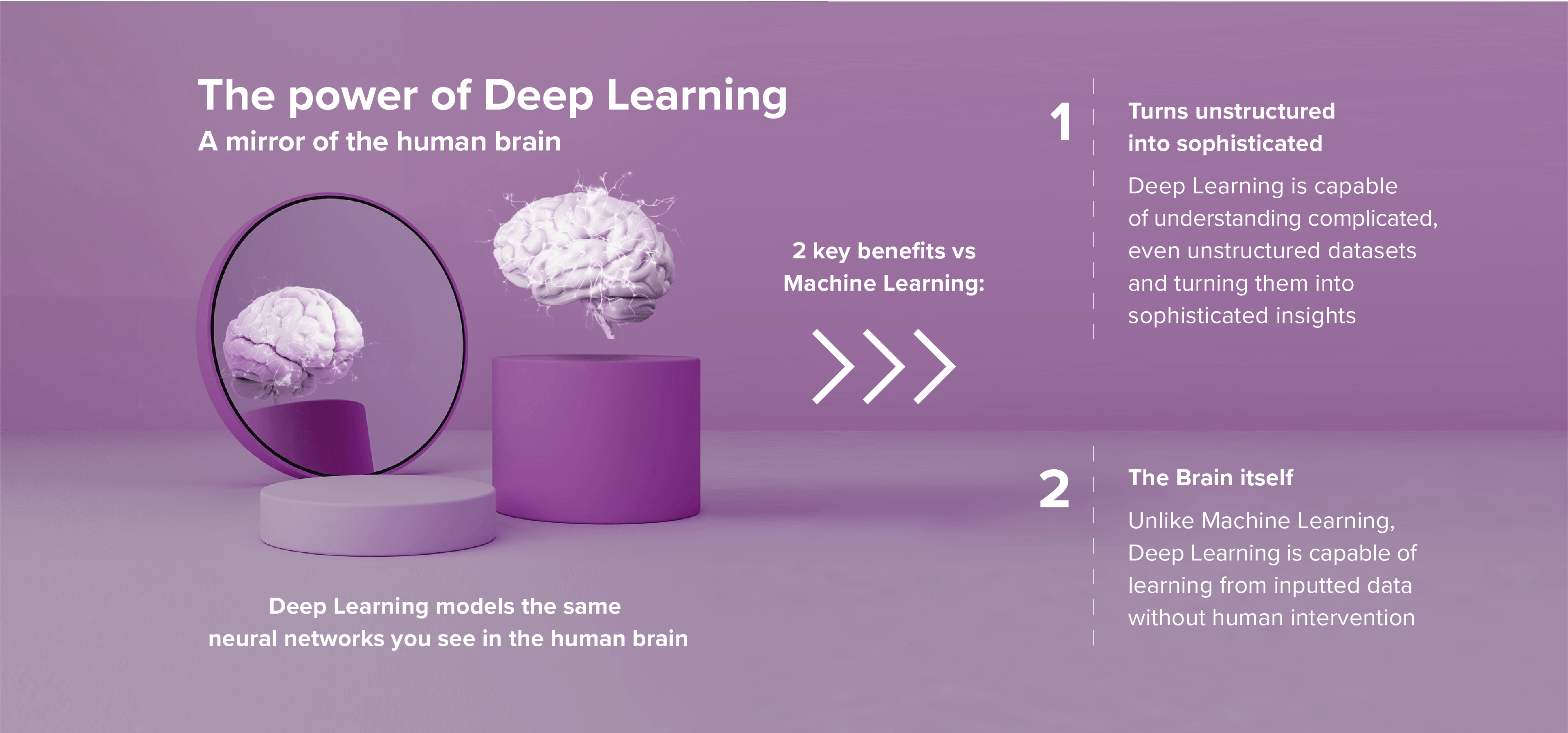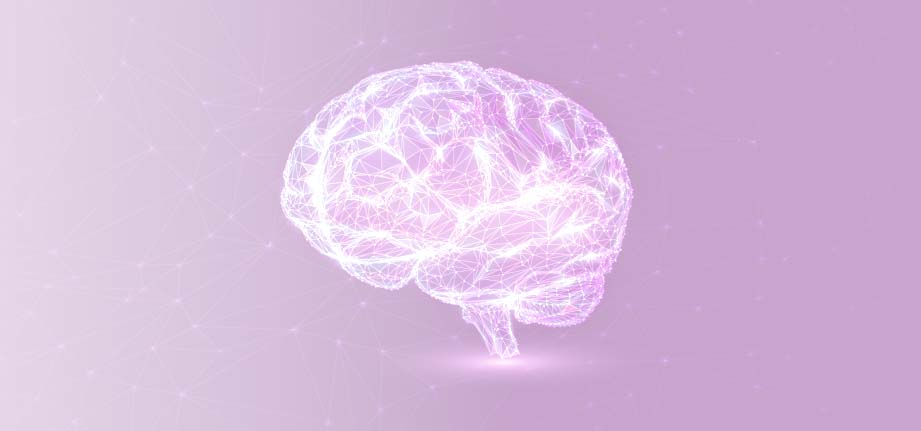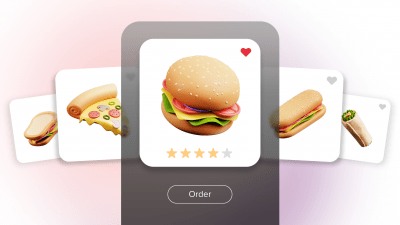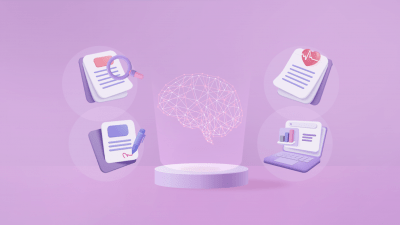Last Updated on: 10th May 2024, 10:42 am
People are bombarded with thousands of ads every day, both offline and online. With the growing popularity of ad-blocking, it’s clear that they are looking for ways to reduce the number of ads shown. One of the big challenges is that most of this ad content is irrelevant to users. This article will explain how AI technology can help advertisers to deal with it and to improve campaign performance with more precise targeting through Deep Learning.
In this article you will learn:
- AI vs. Deep Learning vs. Machine Learning—what’s the difference from a marketing perspective?
- How is AI revolutionizing the marketing industry?
- How can Deep Learning boost conversion and user experience?
- What is a real time personalization display?
Table of Contents:
- AI vs. Deep Learning vs. Machine Learning–the basics
- Deep Learning vs. Machine Learning in digital marketing
- Deep Learning vs. Machine Learning–different technologies create different results
- Revealing what’s hidden
- Offer scoring optimized thanks to Deep Learning
- Real-time personalization display
- Deep Learning advertising is a new standard
AI vs. Deep Learning vs. Machine Learning–the basics
Artificial Intelligence (AI), Machine Learning (ML), and Deep Learning (DL) can be easily confused. In fact, these terms are closely related and often used interchangeably, but they differ in their scope, techniques, and applications. Let’s start by taking a closer look at the differences.
Artificial Intelligence (AI): AI is the most general term of the three. It is a field focused on developing intelligent machines capable of simulating human-like analysis and decision-making. AI includes a broad spectrum of techniques and technologies designed to help machines perform tasks that typically require human intelligence. These tasks may include natural language understanding, problem-solving, decision-making, perception, and even creative tasks like art and music generation. AI can be rule-based or data-driven, and it serves as the foundation for both Machine Learning and Deep Learning.
Machine Learning (ML): Machine Learning is a subset of AI that focuses on the development of algorithms and statistical models that enable computers to improve their performance on a specific task through experience without being explicitly programmed. Machine Learning techniques use data to train models and make predictions or decisions. This approach has wide-ranging applications, from recommendation systems to predictive analytics.
Deep Learning (DL): Deep Learning is a specialized branch of Machine Learning that revolves around neural networks with multiple layers, also known as deep neural networks. These networks are inspired by the structure of the human brain and are designed to automatically learn and extract features from raw data. Deep Learning has achieved remarkable success in tasks like image recognition (e.g. facial recognition and image searches), natural language processing (e.g. customer support chatbots and ChatGPT), and speech recognition (e.g. Siri or Google Assistant). Deep Learning’s power lies in its ability to handle large and complex datasets, although it often requires substantial computational resources.
AI is a broad field aiming to create intelligent machines, while Machine Learning is a subfield of AI that focuses on data-driven model building and decision-making. Deep Learning is a form of Machine Learning that specializes in deep neural networks and is particularly effective in handling complex data.
Deep Learning vs. Machine Learning in digital marketing
Digital marketing has reached a tipping point where the over-exposure of ads is having a negative impact on getting a user’s attention. By appealing to users with deep personalization, marketers can bridge this gap–delivering highly relevant messages to the people most likely to connect with them.
How effective this approach is boils down to how an ad provider has implemented personalization into their recommendation technologies. Those using AI and Machine Learning–the same kinds of technologies responsible for the success of Netflix or Amazon–will have a significant lead over their competition.
Taking advantage of Machine Learning and AI techniques is an important step for a digital marketer. But it’s possible to go further with Deep Learning technologies, using advanced algorithms and data models to analyze and identify users’ needs with greater accuracy.
This kind of solution is especially important for the ecommerce sector, where product inventories are large and diverse. Decisions must be made within milliseconds and tailored to each user’s personal tastes. In-depth analyses done by Deep Learning algorithms mean that personalized offers appear fast and are highly adjusted towards each unique user. The end result is a campaign that delivers the most relevant recommendations, which make the experience less frustrating for the user and more effective for advertisers.
Deep Learning vs. Machine Learning–different technologies create different results
In most retargeting cases, the process starts with a user going through several stores looking at similar products, but not making a purchase. To reconnect with this user and bring them back, the digital marketer will employ a retargeting campaign.
Good to know: Cookieless Retargeting — How Will It Work?
There are two major issues that ecommerce retargeting faces today: what offer to display and how to display it to a particular user. Advertisers try different approaches to adjust the advertising message, so that it is personalized and attractive enough to convince a customer to place an order. Retargeters then locate individual customers with the right message (creative) and then display unique offers (personalized products).
The biggest difference between Machine Learning and Deep Learning is the learning method. Both Deep Learning and standard Machine Learning are designed to learn from large amounts of data. However, Machine Learning has to be taught how to learn, what to analyze and what outcome it should work towards. In traditional Machine Learning, feature engineering often plays a crucial role, where human experts manually select and design features that the model uses for learning. This process can be time-consuming and may not capture all the relevant information nestled within complex data.
When Deep Learning is applied, the learning method changes. It uses neural networks that mimic how the human brain works in terms of information processing and decision-making. Similar to how humans learn from practice, a Deep Learning model tries a number of different things before it makes a final decision. This approach, known as representation learning, allows Deep Learning models to automatically extract features from raw data, eliminating the need for extensive manual feature engineering. This not only reduces the human effort required but also makes Deep Learning particularly effective in handling unstructured data like images, text, and speech.
In ecommerce, the self-learning procedure learns from experience or simulations, resulting in a more accurate and faster identification of purchasing potential. By automatically recognizing complex patterns and correlations in data, Deep Learning models excel at tasks like personalized product recommendations, fraud detection, and customer sentiment analysis, making them invaluable tools for enhancing the ecommerce experience.
All of this occurs without any human input or manually implemented rules.

Revealing what’s hidden
Deep Learning has enabled retargeters not only to analyze the basic user behaviors such as what products or which product categories were visited, but also the ‘hidden layer data’. Just as in body language, micro-expressions can reveal our true, sometimes undiscovered intentions. Sophisticated algorithms using Deep Learning made it possible to analyze, for example, the time between viewed products, prices of viewed products, or even the sequence of visited subpages of the store. Equipped with this information, machines interpret exactly what the user was doing in the store and try to predict their actual shopping intentions. Thanks to loads of historical data algorithms, it can assume what products the user will be most interested in.
However, depending on the product category and consumer characteristics, the decision process of the final purchase may take up to several weeks. Seemingly irrelevant, hidden information such as the frequency with which a user visits a given store or the device is used, and may cause the recommendation mechanisms to be tipped off much earlier for products that user will be looking for in the near future.
By analyzing the customer’s past purchase history, the model will also be able to predict with high probability when the customer will return to the store for a particular product or service. Airlines, by analyzing a customer’s bookings, know how far in advance the customer will look for attractive offers and which destinations will potentially be of interest to them. A store that offers cosmetics or products that are used up relatively quickly can, thanks to Deep Learning, suggest to the customer that it is high time to think about replenishing their cosmetics bag with products that are about to run out, just at the right moment.
Offer scoring optimized thanks to Deep Learning
With all of this intelligence, the next step becomes how (and in what order) offers should be presented on a creative. Thanks to ‘offer scoring’ each product in the shop’s feed is consistently reevaluated. The difference between Machine Learning and Deep Learning is that DL algorithms analyze offers and assess how attractive they are from the particular user point of view, without generic clusters. This fine-tuned approach ensures that each user is presented with products that align precisely with their unique preferences and behaviors.
In a standard approach without Deep Learning, retargeters use Machine Learning on banners to make a mix from some simple segments, e.g. products viewed by the user, similar products from the same category (i.e. based on the history of other consumers), and the most-sold products in a given store. However, the limitations of this approach become evident when compared to Deep Learning’s more sophisticated capabilities.
Another difference between Machine Learning and Deep Learning is that the latter is much more sophisticated. The process of selecting an appropriate product is more flexible, more product combinations are possible, and the final list of products displayed on a banner is even more personalized. This approach allows retargeters to implement a rule in which there is no single-working scenario for a group of users. Those algorithms always go deeper to the level of an individual user, and they look for the best offers or the order in which offers should be displayed on banners for them.
The process of predicting future customer behavior on the basis of a number of variables (independent and disturbing) is called propensity modeling in statistics. The result of such a prediction is nothing but the probability of conversion. Thanks to the possibilities offered by Deep Learning, the propensity index can be calculated independently for each customer of the store in fractions of seconds and thus offer tailor-made recommendations. This rapid and precise calculation ensures that recommendations are not only highly personalized but also delivered to users at the most opportune moments, maximizing the chances of conversion.
Real-time personalization display
No user lives in a vacuum, so their behavioral profiles change all the time. A Deep Learning recommendation system in retargeting should be able to build a behavioral profile in real time, adjusting what is presented on the banner each time an advertisement is displayed. This dynamic approach ensures that the retargeting algorithms stay in sync with the user’s evolving preferences and interests.
Some mechanisms based on the older AI technology build and rebuild the behavioral profiles at fixed time intervals. This means many displayed products are those the user is not interested in anymore. Deciding what should be presented every time a banner is displayed allows algorithms to respond and adjust accordingly to a given user’s reaction to the previously shown offers. As a result, its behavioral profile is built in real time and is based not only on what the user was doing in the store, but also how they responded to the advertising message. This is level of real-time adaptation is very difficult to achieve, given that the time frame, from the moment you get information about the possibility of displaying a banner until its display, is typically less than a second.
Thanks to powerful algorithms and constant analysis, Deep Learning retargeting mechanisms are able to rebuild users’ behavioral profiles in real-time. RTB House data shows that after implementing Deep Learning into recommendation mechanisms, users clicked on ads up to 41% more than usual. Such growth is noted especially in sectors such as fashion and multicategory e-shops, where the possibilities to use cross-categories recommendations are almost endless, demonstrating the significant impact of real-time behavioral adaptation on campaign performance.
Good to know: The Top 20 Deep Learning Applications You Need to Know
Deep Learning advertising is a new standard
When the overstimulation of ads lowers their effectiveness, advertisers and their partners can turn to leading, such as Deep Learning. Simple retargeting is no longer enough, and investing in newer solutions ensures that brands not only survive, but thrive in the face of future competition.
Of course, it is extremely important what the algorithm decides to present to the user, but it should be noted here that Deep Learning starts its work a little earlier. First, the algorithm considers all the information and data available about the user, such as browsing history, preferences, and behavior, and, on this basis, tries to predict how likely it is that they will perform the desired action–e.g. click or conversion. In other words, before deciding what banner and what content to present to the user, DL decides whether taking such steps is really worth it, optimizing the use of advertising resources effectively. Considering the fact that 90% of users find non-personalized ads annoying, and for 44% it is a reason to switch to brands with better approach to marketing communications, it is extremely important to direct advertising messages to users only in justified cases.
Deep Learning is becoming more and more popular and changes many different businesses from automotive, through entertainment to marketing. Thanks to Deep Learning, the advertising industry is gaining well-tailored and personalized messages for users, enhanced user satisfaction and even more effective campaigns.
Therefore, it can be concluded that a strategy lined with personalized retargeting technology is no longer just a good recommendation for companies that want to increase conversions, but a mandatory component of any winning marketing strategy.





